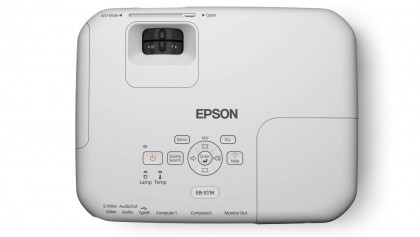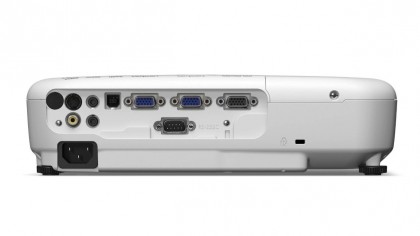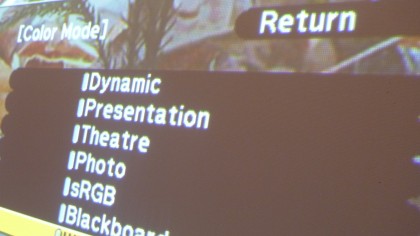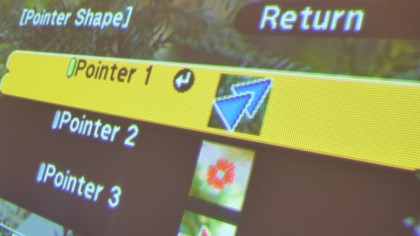TechRadar Verdict
Pros
- +
Brightness
- +
Portability
- +
Usability
- +
Image alignment options
Cons
- -
4:3 shape
- -
USB slot only reads photos
- -
Low resolution
- -
Poor built-in speakers
- -
No Wi-Fi or networking options
Why you can trust TechRadar
Selling at a mere £409.99 or less online, Epson's EB-X11 is an attempt to please everyone in a compact, highly capable package.
Measuring just 295 x 228 x 77mm and weighing 2.3kg, the EB-X11 is made for a life on the move (check out the handy lens cover that instantly shuts off the lamp and speakers), though it doesn't come with any kind of bag or cover.
What makes is more adaptable than some is its relatively high brightness rating of 2600 ANSI Lumens - which ought to cope with ambient light - though there are a few limiting factors.
Its 1024 x 768 pixels mean an XGA resolution that does make high-definition images possible, but only just. With no Full HD capabilities (though it can process 1080p images), images are best kept to about 70-inches maximum - but that ought to be enough for many classrooms and boardrooms.
Specifications
The ins and outs on this 3LCD projector - whose lamp is rated at around 4,000 hours - mark it out as a plain-and-simple data projector. The chief clue is a lack of video-friendly HDMI slot, but don't think the EB-X11 is therefore a basic model.

There are plenty of options for hooking up a laptop or PC: S-video, composite video, two USB slots - Types A (for showing photos from a USB thumb-drive in JPEG, PNG and GIF formats) and B (for 'plug and play' pictures and sound from a PC) - and a regular 15-pin D-sub RGB input.

There's also a monitor output, and an RS-232C control terminal for integrating the EB-X11 into an AV system. It's got more audio options than most projectors, too, with a set of phono inputs alongside a 3.5mm audio output, a feature that betrays the existence of its own 2W mono speaker.
Performance
The EB-X11 is a cinch to set-up.
A drop-down but tweak-able prop stand on the front is complemented by two screw-down legs at the back - an unusual double-act - but it's the various image alignment options that make the EB-X11 shine.
The lens itself has manual dials to adjust its 1.2x zoom and focus, and a horizontal keystone adjuster just behind. Vertical keystone is done automatically.
Placed just a metre from our test screen the EB-X11 produced a crisp, bright image measuring 36 inches, though considering its lack of ultimate HD detail we settled on placing it two metres away, from where we quickly aligned a good-looking 72-inch image.
Images from the projector



We attached a Netbook via the USB Type A and installed the Epson USB Display software and wizard to get instant desktop mirroring on the EB-X11.
It was then possible to take control of the cursor onscreen, though it's far from perfect; it replicates the shape of the host computer's desktop area, so black bars at the top and bottom of the image are likely.
The cursor function is cute, but not great; the remote needs some kind of joystick because the five directional buttons are a bit stunted and slow.
Deliver video over USB and it stutters, though the audio is excellent.
The high brightness lamp makes the EB-X11 usable in daylight, and that's the big advantage. However, if we're talking image finery, there's a flip-side; low contrast. It's fine for data, but try watching video and the colours seem over-cooked. The pixel grid is always obvious, too.

Video also brings quite a lot of blur, so we don't recommend taking the EB-X11 home for the weekend to watch a movie. Keep it in the office, where it will excel with bright projections of graphics and documents that always look crisp and well-defined - as long as you don't blow up the image too much.
Verdict
Getting the image spot-on can sometimes be tricky, but Epson offers plenty of help with some quick manual adjustments and an excellent automatic keystone correction mode.
We liked
We like its small, portable size and its punchy, bright and accurate images, too.
The icing is the noise, or lack of; the EB-X11 produces an average of just 65 decibels in operation on full brightness, but it reduces to 57 decibels in Eco mode. Talking of noise, the built-in speaker is absolutely great - it goes to a high volume without distorting, and has a lot more range than we had expected.
We disliked
The lack of HDMI is understandable on a data-centric projector, but it is a shame the EB-X11 can't play video files stored on a USB thumb-drive.
We're also missing the lens shift levers that Epson often fits its projectors with, and which make off-centre placement much easier.
Video isn't what this projector excels at, though it doesn't claim to.
Final verdict
Without any networking or app options and with media playback limited to photos from a USB stick, the EB-X11 is pretty basic and doesn't make the jump to showing decent video.
However, there is room for low-priced but ultra-bright projectors like this one - its powerful lamp and excellent, if limited, images make sure of that.
Highly portable and very dependable, the EB-X11 is so easy to set-up and fulfils its simple brief with the minimum of fuss. It's a lesson in how to make a great classroom projector.
Jamie is a freelance tech, travel and space journalist based in the UK. He’s been writing regularly for Techradar since it was launched in 2008 and also writes regularly for Forbes, The Telegraph, the South China Morning Post, Sky & Telescope and the Sky At Night magazine as well as other Future titles T3, Digital Camera World, All About Space and Space.com. He also edits two of his own websites, TravGear.com and WhenIsTheNextEclipse.com that reflect his obsession with travel gear and solar eclipse travel. He is the author of A Stargazing Program For Beginners (Springer, 2015),

